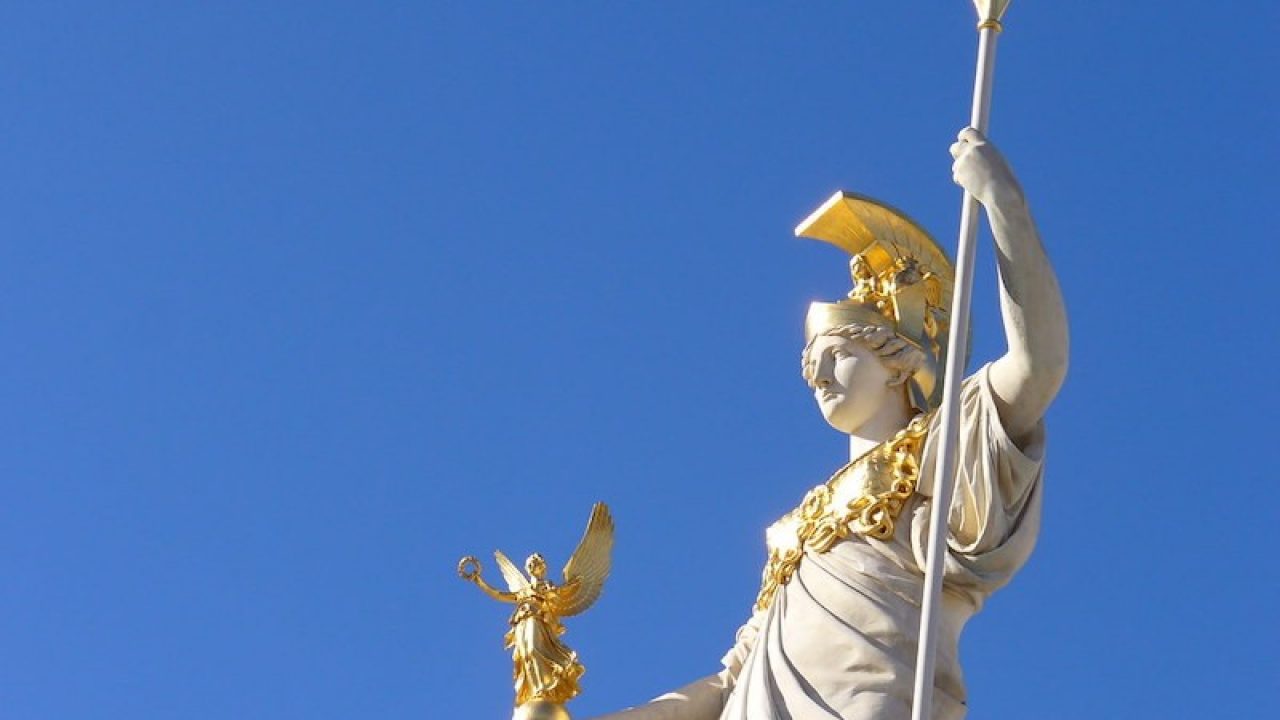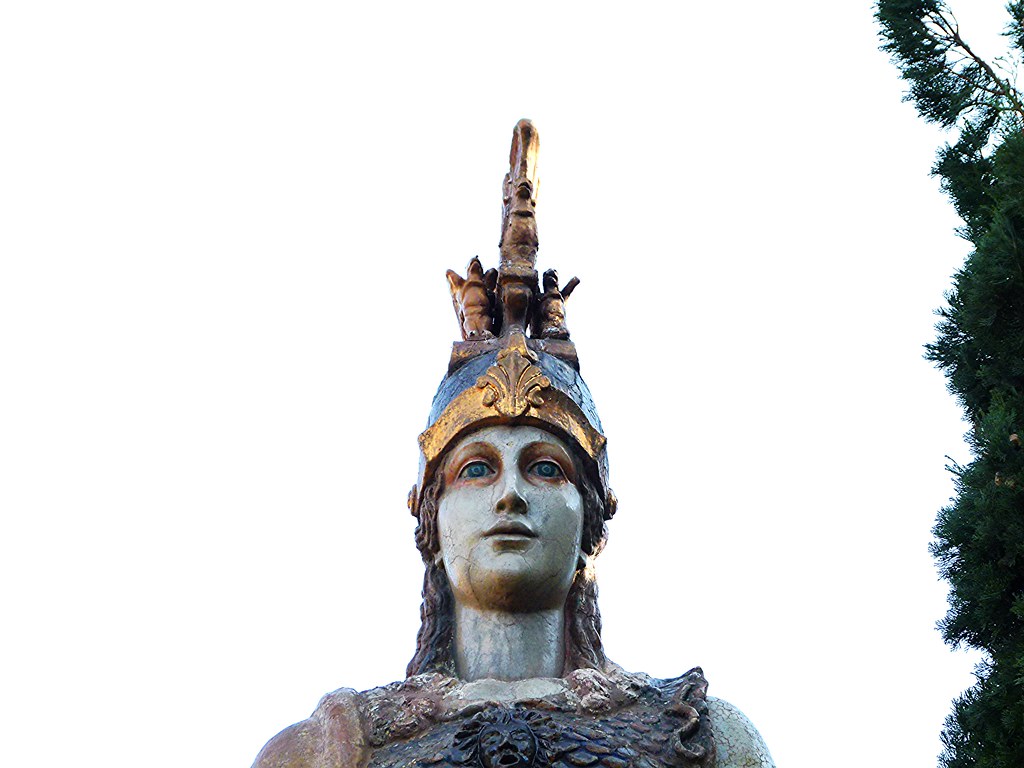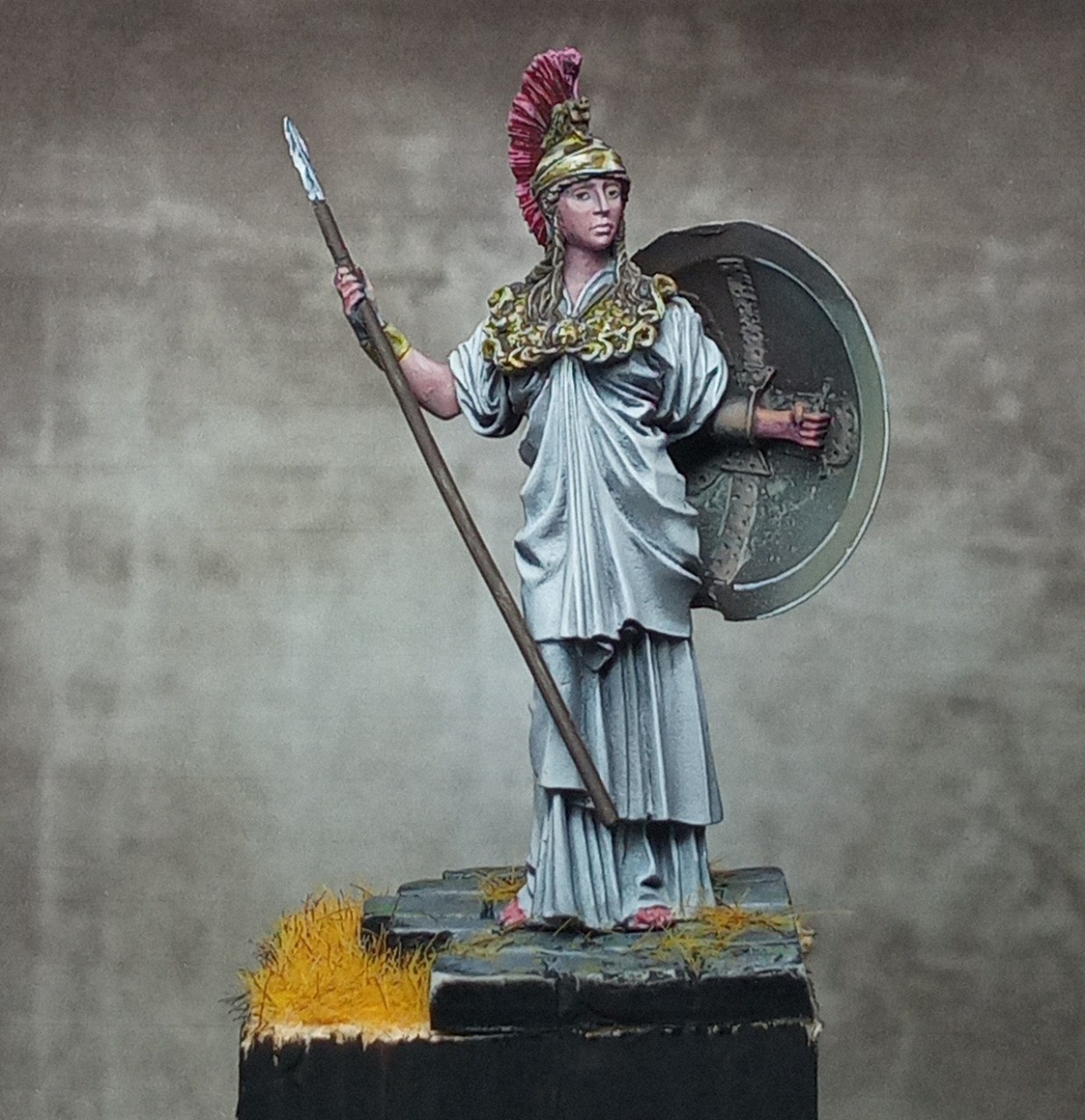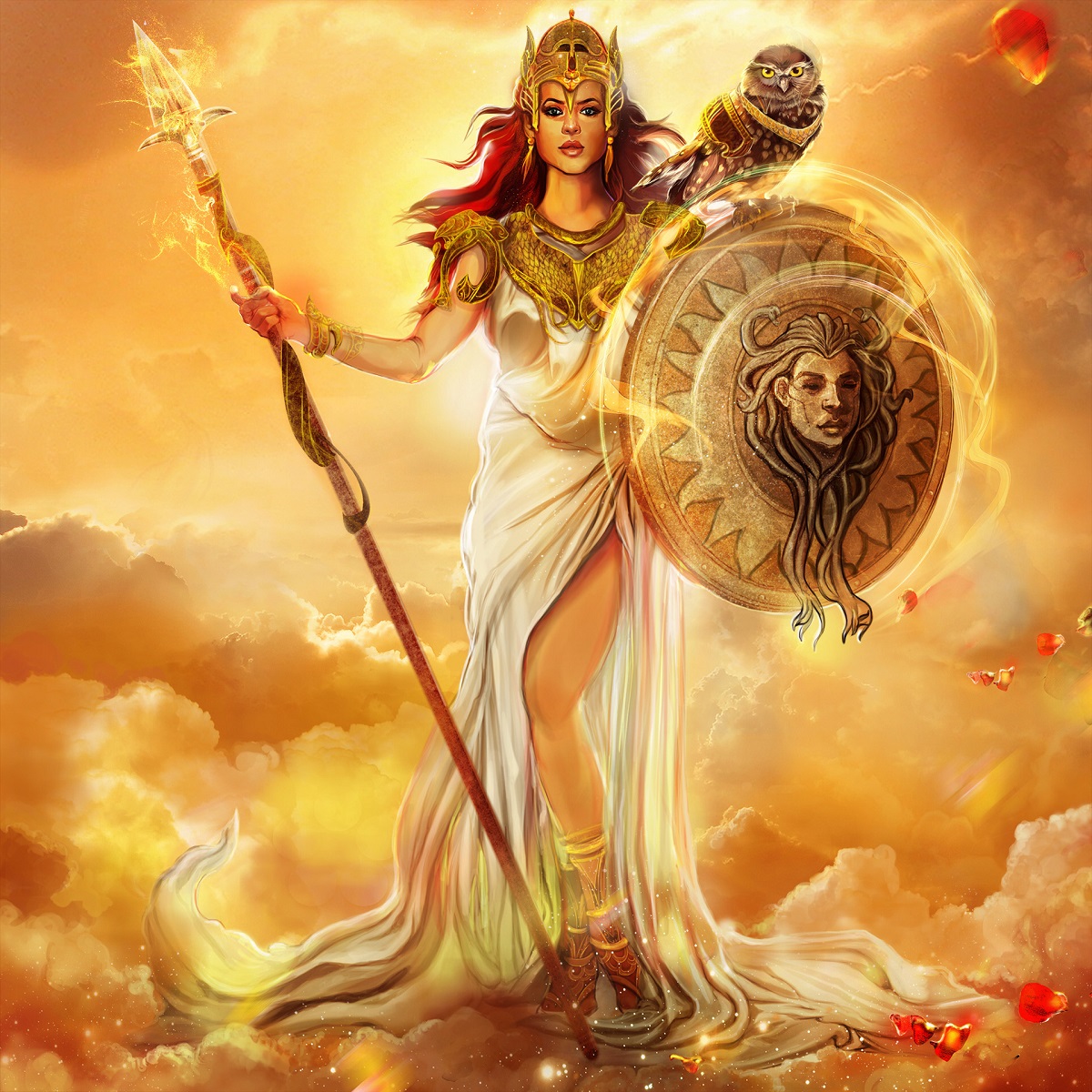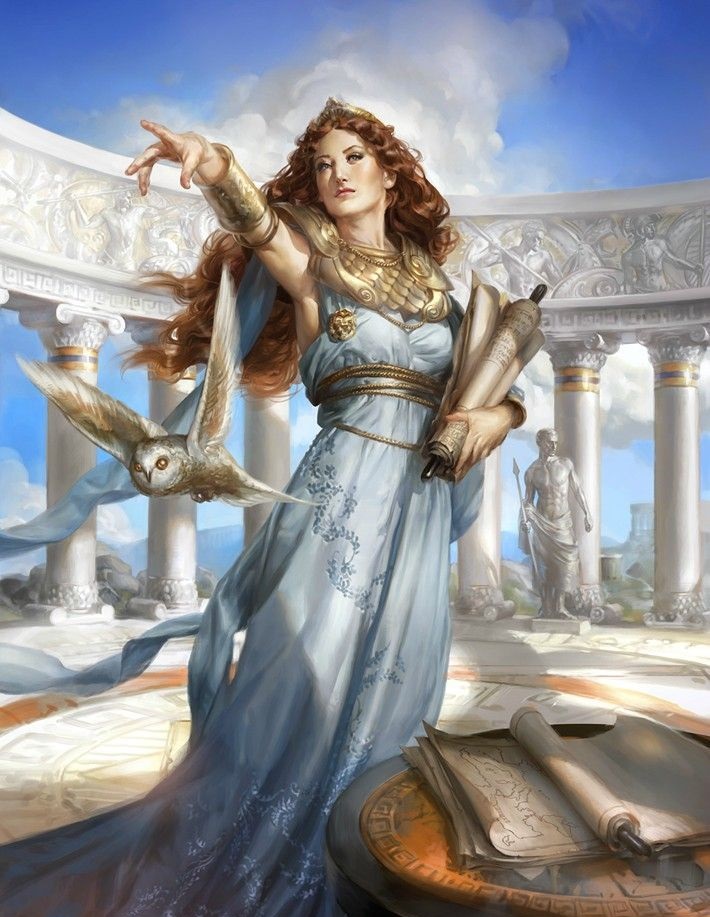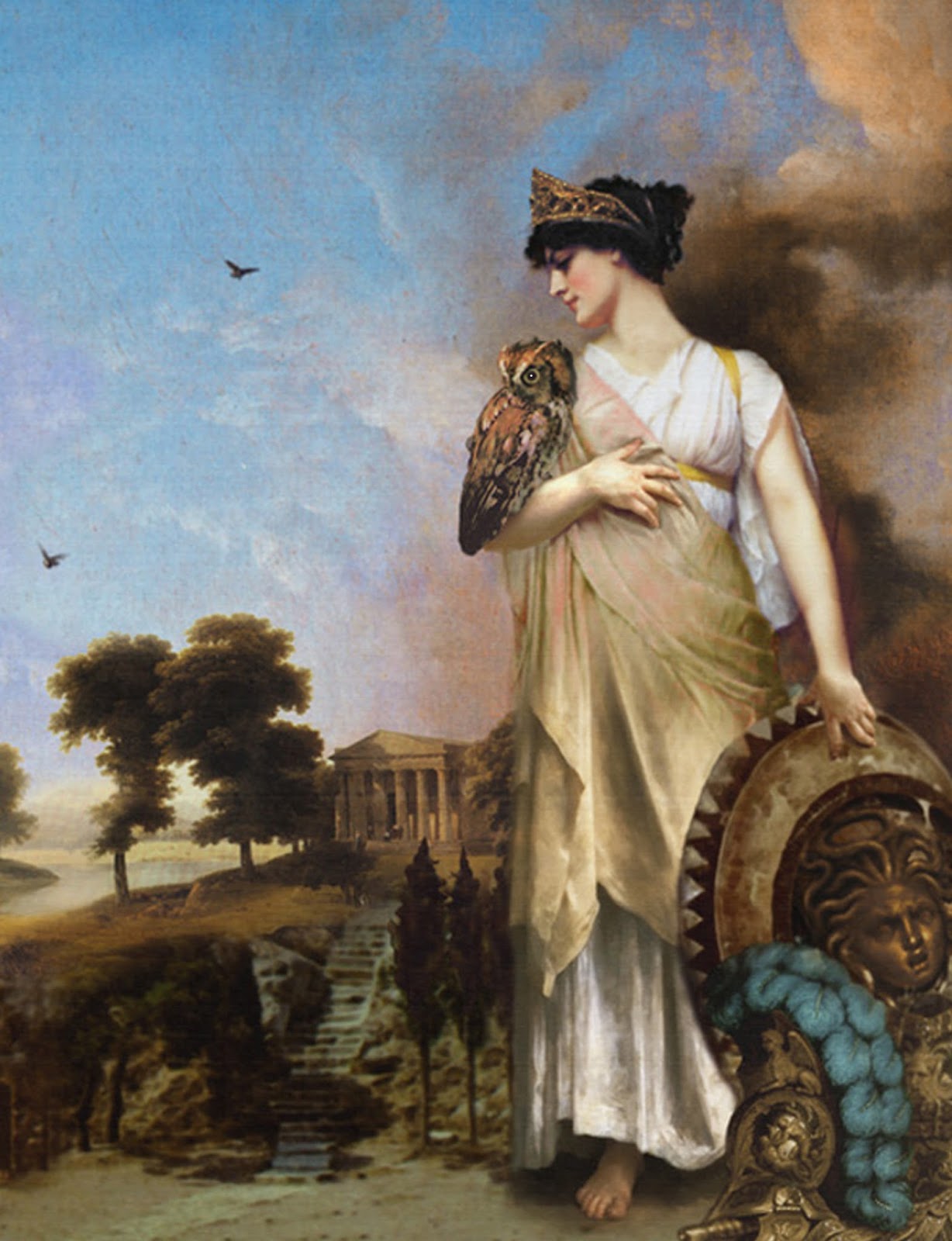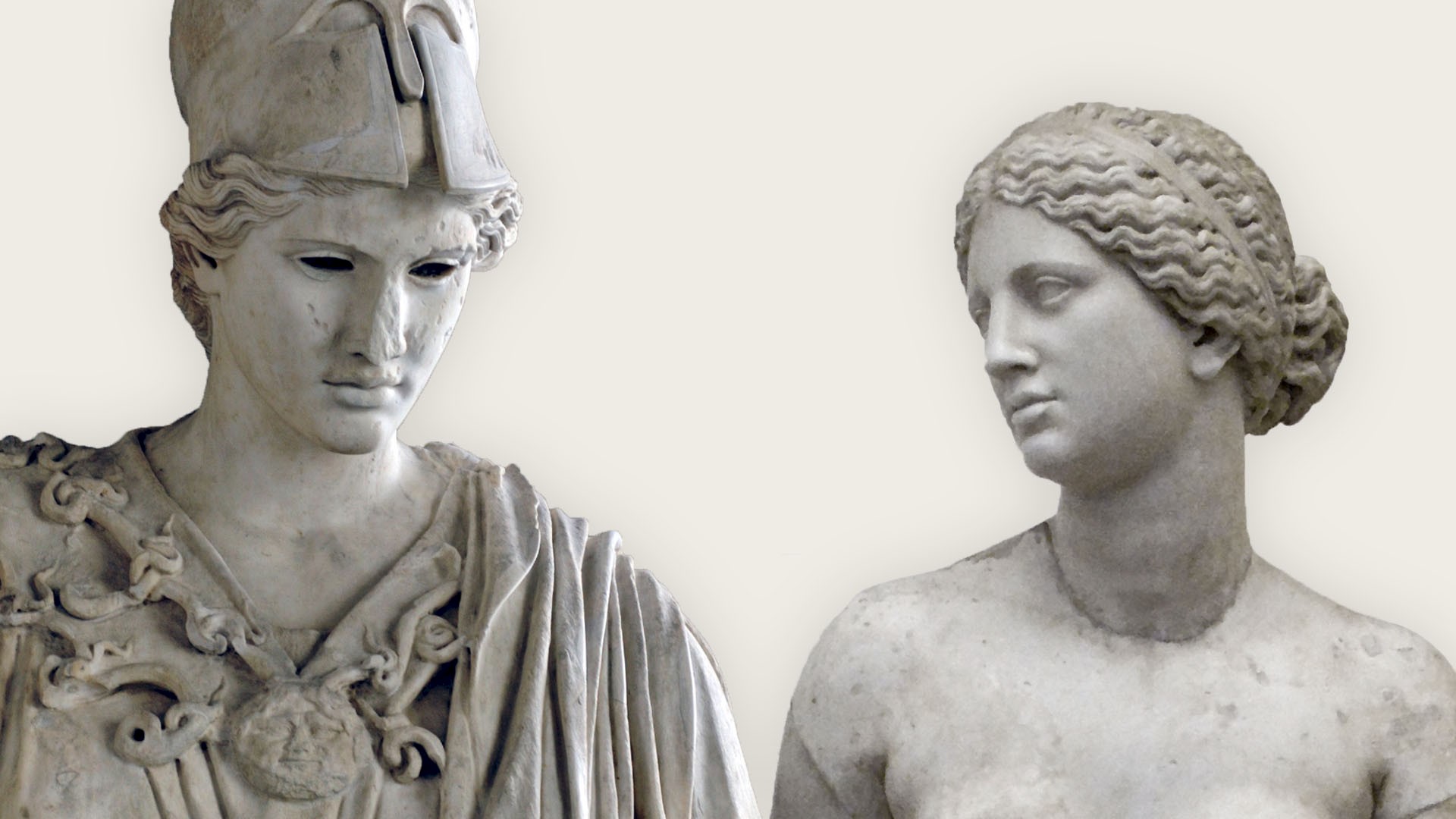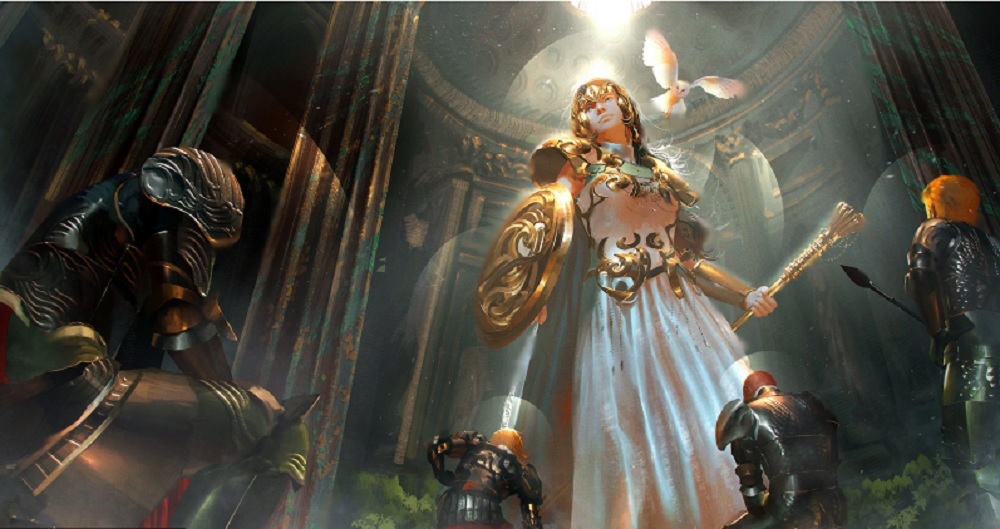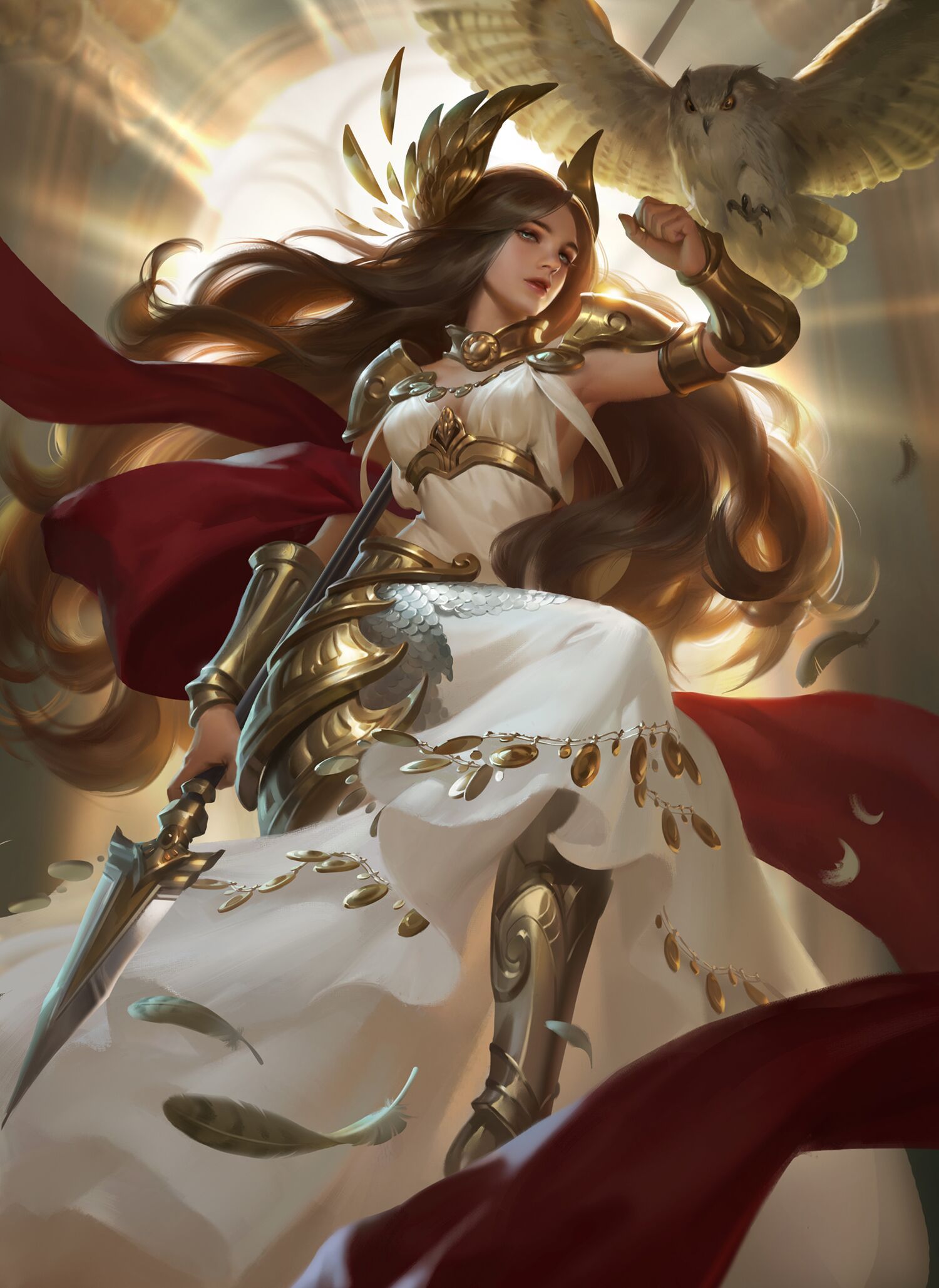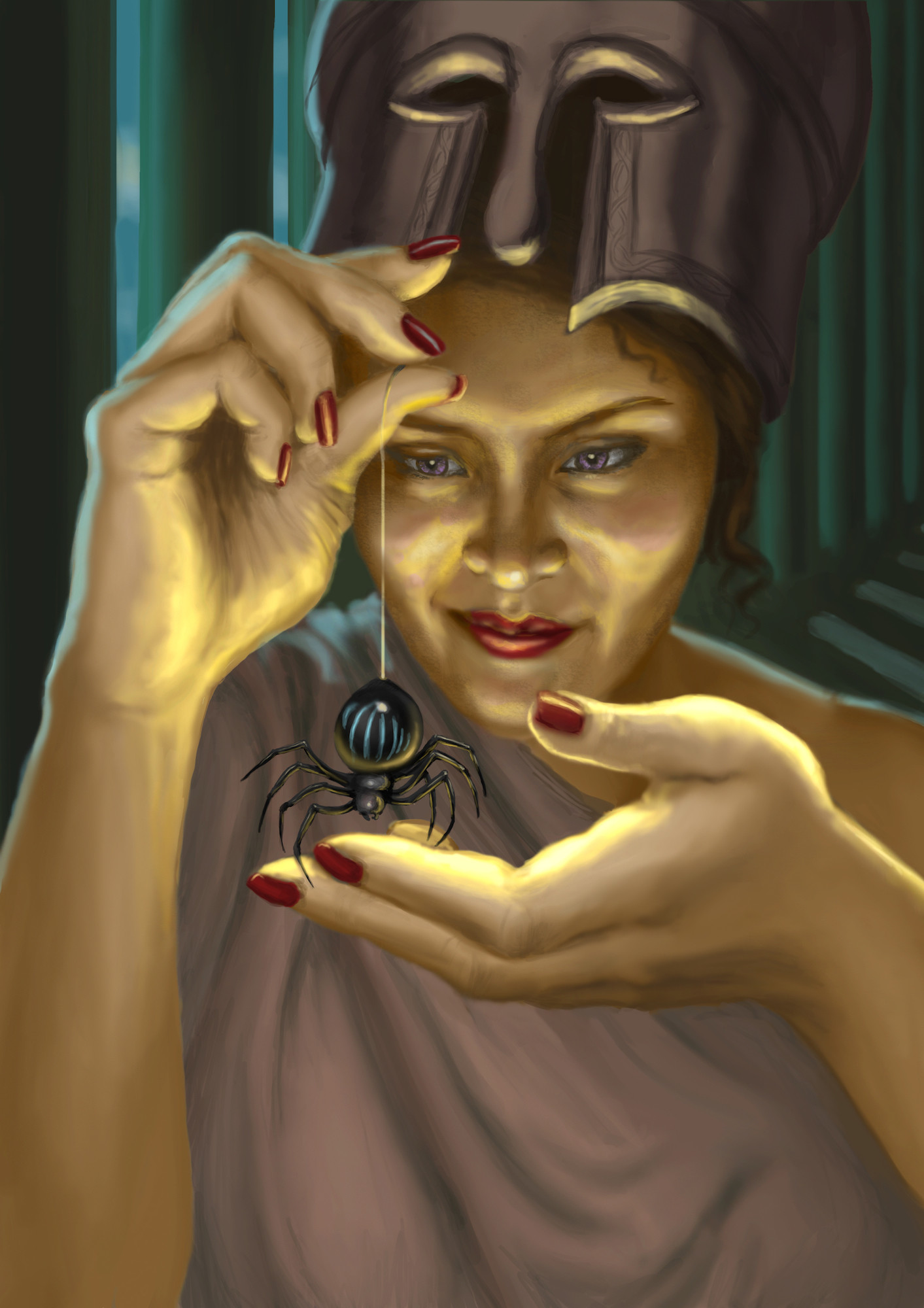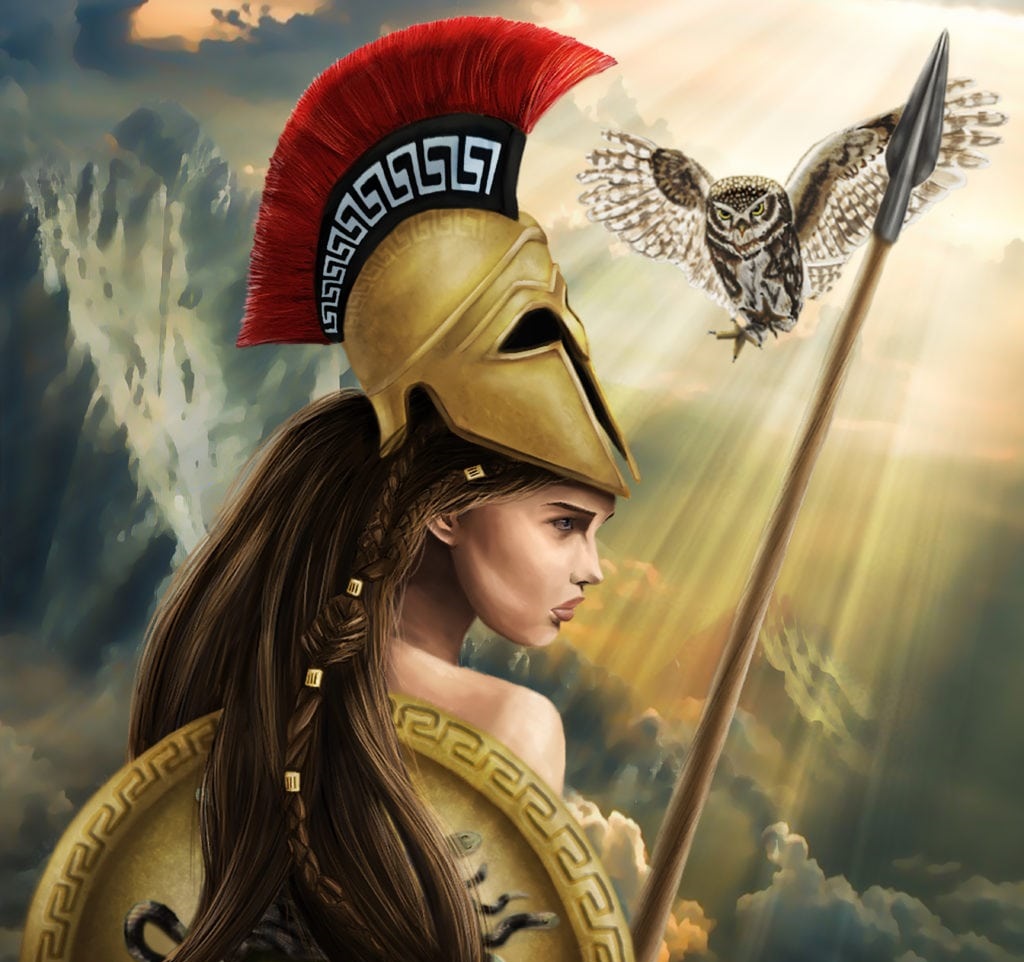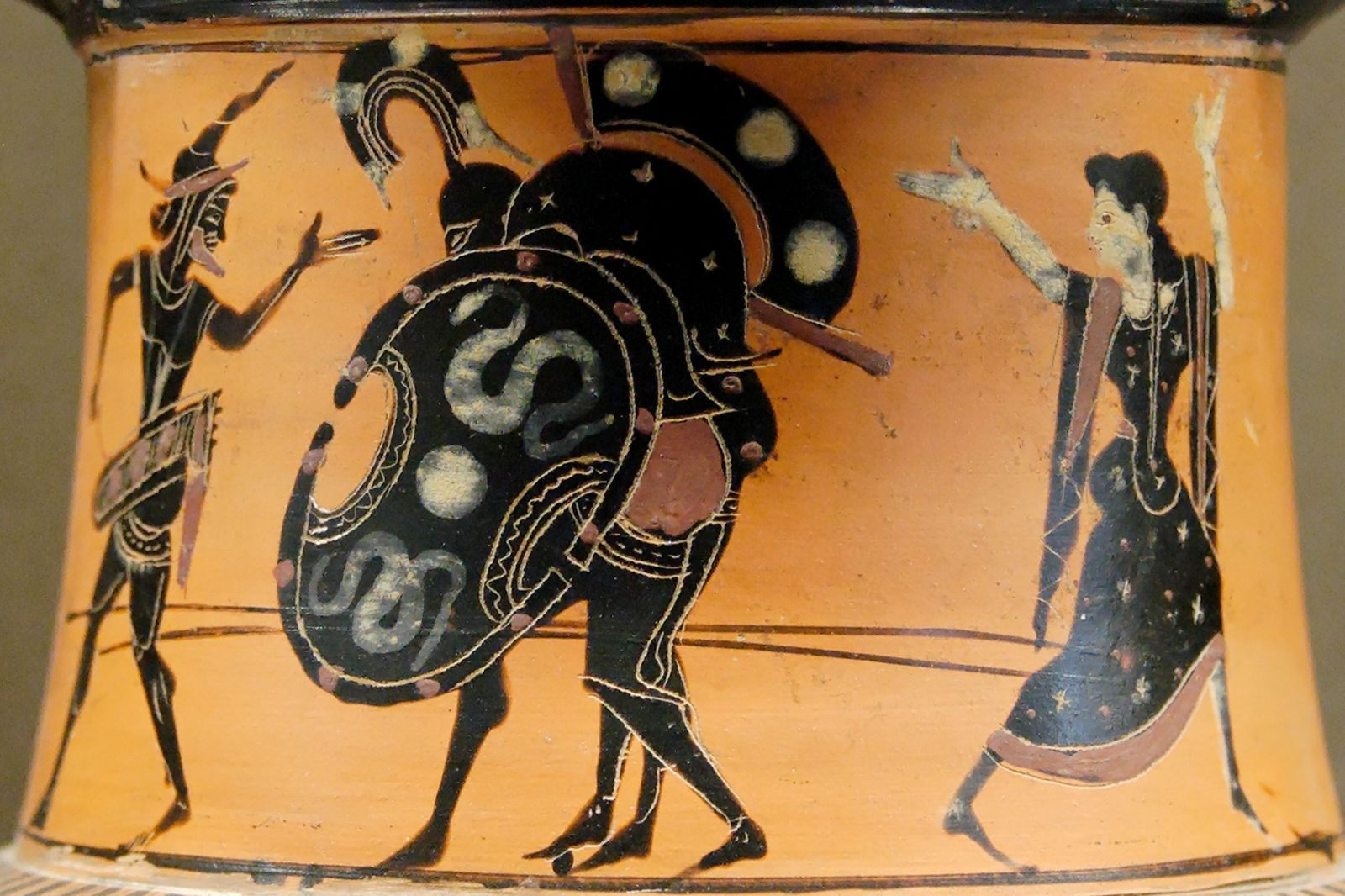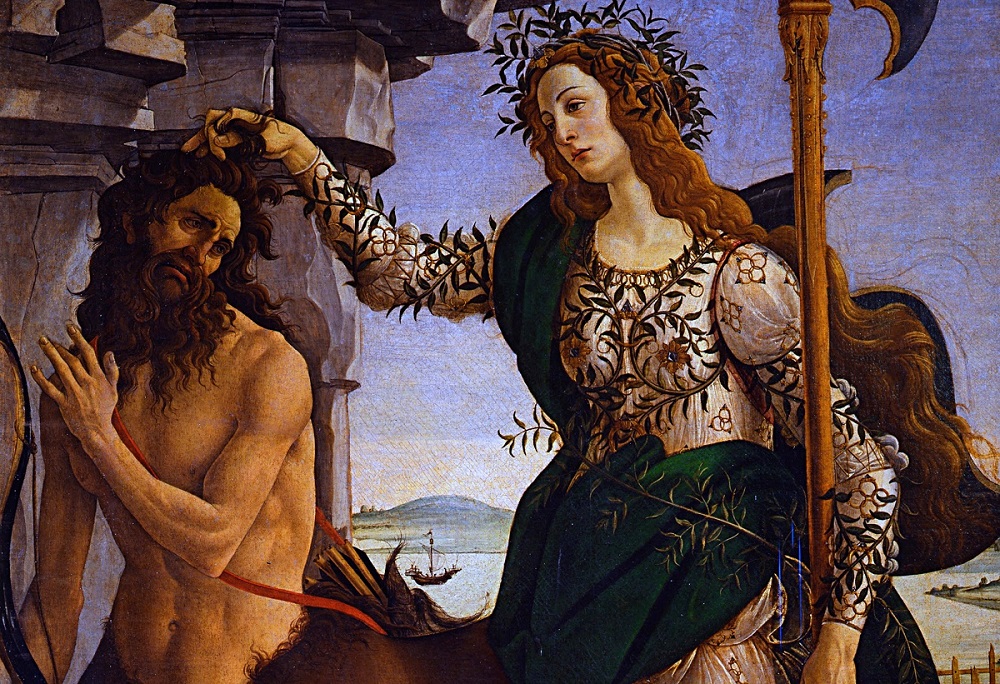One of the most relevant Greek goddesses in mythology is Athena, also known as Pallas Athena, daughter of the sovereign of Olympus, Zeus, and the divinity who gave name to the city of Athens, current capital of Greece. If you want to know more about her, we invite you to continue reading.

Pallas Athena
First of all, it must be said that she was the goddess of wisdom, war and crafts. In Greece, she received many names according to her qualities or her place, Athena or Pallas Athena were some of them, even in Rome she was syncretized as Minerva. You may know this, but she was considered the protector of different cities such as Athens, from which this deity is named after her.
He was normally depicted with a helmet and a spear, his symbols being the owl, the serpent, the olive tree and the Gorgoneion amulet. At first, she was considered a tutelary goddess of the Aegean palace, closely associated with the city. his epithet pulleys It derives from cops, which means city-state, locating its temples in high areas of the land.
It is worth mentioning that many monuments were dedicated to the goddess throughout Greece, the most famous being the Parthenon located on the Acropolis of Athens. Among the names she received, as protector of artisans and weaving she was called Athena Ergane, instead, being a warrior goddess, between her roles she led warriors in battles as Athena Promachus.
In the Greek pantheon, Athena was one of its most important deities. The virgin goddess of wisdom, considered a war leader, protector of the arts and weaving, creator of the flute and the trumpet, taught mortals the art of navigation and the use of the loom. In fact, among all these general ideas that we mentioned, it was she, along with Hephaestus, who created Pandora, the first woman. If you want to know more about this story, we invite you to read: Pandora's box.
He also protected and guided the most important Greek heroes and contributed to the Achaeans during the Trojan War. In her physical appearance, Pallas Athena is described as a tall and attractive woman. In the sculptures she appeared with broad shoulders, strong arms and narrow hips, which gave her a masculine appearance.
Some describe their eyes as similar to those of an owl, others as gray eyes. He generally has a serious and thoughtful expression, his face is oval, his hair is abundant and is always combed over his temples.
The god Zeus showed his favoritism for Athena, sharing his weapons only with her. In times of war he preferred strategy and discipline to violence and slaughter, while in times of peace he only wore his peplum, although he almost always wore his helmet, only arming himself when circumstances demanded it. She was patient with mortals, she tried to reason with them and persuade them, even if she was injured or offended.
Origin of Athena
If you are looking to know the origin of Pallas Athena, you should know that there are different versions of how he was born. The first of them was provided by the great author Homer, since in his work on the Iliad in book V, he explains that Ares (god of war) verbally confronts Zeus telling him that he protected Pallas a lot, for the sole reason having spawned her.
Another version says that she is the daughter of Zeus with Metis, the titan daughter of Oceanus and Tethys, which was proposed in the poem Theogony.
In the latter it is detailed that the god, having sex with her and getting her pregnant, later found out that Gea and Uranus prophesied that the titan would give birth to children wiser and more powerful than him. Then he was afraid that her offspring would overthrow him and, following the prophecy, he deceived Metis so that she would allow herself to be devoured by him "locking her up in her womb", which would not work, because she had already conceived. .
Another story about this fact, written in the second century AD, tells that Zeus abused Metis without being his wife. She tried several times to escape from him by transforming from her, but in the end Zeus caught her, raped her, and then swallowed her. He then had six more wives, until he married Hera, which would be his last. If you want to know more about other mythological figures, we invite you to read: mythological characters.
Later, Zeus began to suffer from such a terrible headache that he was overwhelmed and ordered someone (which according to the source could be Prometheus, Hermes, Ares or Palaemon) to open his head with a labrys, a Minoan ax of two heads, then Athena jumped from the god's head in the form of a mature, fully armed woman.
The members of Olympus (kingdom of the gods) were shocked by the emergence of the new goddess, so much so that the sun god, Helios, stopped his chariot in the middle of the sky crying loudly, in fact, the sky (Uranus) and mother earth (Gaia) had trembled with emotion. Although Hera was so angry with the birth of Athena, that she herself conceived and gave birth to Hephaestus some authors say.
Other versions say that Hera was never angry about the event, on the contrary, she was happy and received her as if she were her own daughter. You can also consider another hypothesis, which describes that the goddess Pallas Athena was originally the fruit of the nymph known as Tritonis and of Poseidon, the god of the seas.
It was the Hellenic historian Herodotus, who mentions that the new goddess became angry with her father and left with her uncle, Zeus, who would receive her and welcome her as his own daughter. This story relates that Athena received her education with the daughter of Triton, another god, who was called Pallas. Take this last fact very much into account, because later we will delve into this.
As explained above, there are many stories about the birth of the goddess. On the one hand, Justin Martyr, a Christian apologist from the XNUMXst century AD, said that when Zeus intended to make the world through the logos (the word), he thought of Athena and thus the goddess was born without coitus.
Another narration of the events establishes that the god of thunder (Zeus) swallowed Metis, she was already pregnant with Brontes, a Cyclops. Although it is also said that Athens could be the daughter of Palante, a winged giant that she would kill and use her skin as a shield.
goddess etymology
His name was associated with the city of Athens from the beginning. In ancient Greek the city is called Atenai (Ἀθῆναι), a reference to a brotherhood dedicated to the cult of Athens, according to mythology.
Consider that ancient scholars argued over whether Athens was named after the goddess or she was named after the city, yet there is now consensus that the goddess Pallas Athena is named after the city.
Additionally, one of the many names she received throughout history was Athena Parthenos, which could mean "the virgin", because she never committed to someone, not even as a lover, and completely rejected marriage, just like who was never carried away by the emotion of love.
On the other hand, in this topic on etymology (origin of the name), it must be said that in ancient Greece it was normal for cities to take the names of the deities they worshipped. An example is Mycenae, where the goddess was Mycena, and at Thebes, the deity was known as Theba.
For his part, the German specialist Günther Neumann suggested that the name Athena had its roots in the ancient kingdom of western Anatolia, composed of the word "ati" meaning mother and the name of the goddess Hannahanna abbreviated as "Ana". In fact, the theonym Athana potniya is commonly translated as "Lady Athena" and its real meaning is thought to be "the Lady of Athens" (potnia of At(h)ana).
Likewise, the philosophical Greek Plato in his dialogue Cratylus raised some etymological speculations based on the opinion of the ancients, including the poet Homer who called Athena "mind" (noũs) and "intelligence" (dianoia) and even called her "divine intelligence". ” (theoũ nóēsis), meaning that she possessed the mind of god (a theonóa), giving her the name Theonoe, or perhaps “knower of divine things” (ta theia noousa).
Another philosopher who offers interesting reasoning on the subject is Plato. He wanted to identify the goddess with "moral intelligence" (en éthei nóesin) and for this reason he called her Etheonoe, but in the end, looking for a more friendly name, he decided on Athena.
Finally, there is a possibility that its name does not belong to ancient Greek, but rather that it is an Attic deity worshiped before the arrival of the Hellenes, Ionians and Dorians, which was venerated in the form of its totem animal: the owl.
epithets
Athena is one of the most important Olympian gods, she had many functions ranging from agriculture and the protection of artisans, through the administration of laws and the execution of justice, to the protection of the state through war. Therefore, it is not surprising that so many functions have so many epithets.
Athena Parthenos
The goddess received the ancient Greek name Athena Parthenos, which literally means "the virgin goddess" from which the name of the Parthenon of the Acropolis of Athens is derived, the most famous in which the divinity was worshiped and in fact, still remains. existing.
Take into account that she was lovingly requested by many gods and titans, but she rejected them all, she did not have a husband or a lover, although it was not only to preserve her chastity but also to comply with the moral principles she had.
Moreover, it is said that Medusa dared to make love with Poseidon inside a temple dedicated to the goddess and she was punished by transforming her hair into snakes and her eyes would have the ability to petrify whoever looked at her.
Some time later Perseus would arrive, with the protection of Athena herself, to decapitate Medusa and deliver her head to the goddess. From that moment on, the goddess would carry the creature's head engraved on her shield.
Another story related to this particular name or epithet relates that when Tiresias was young, he surprised her while she bathed naked and left him blind as punishment, although in compensation he gave her the ability to speak the language of birds to understand and the gift of predict the future. Remember that in our blog you will get more information about myths and legends, in addition to this goddess called Pallas Athena, such as: god jupiter.
Pallas Athena
Do you remember that we told you earlier that the goddess had a friend by the name of Pallas and that it would be an important piece of information? Next, we will talk about the origin of this interesting denomination about Pallas Athena.
To begin with, it should be mentioned that Pallas derives from “pallas” which in ancient Greek could mean brandish (a weapon) or could also mean young woman. Historian Walter Burkert detailed that "she is the Pallas of Athens, Pallas Athenaie, just as Hera of Argos is Argeie here."
When these origins were forgotten, myths were developed that would explain epithets such as the one narrated by Philodemus of Gadara, who said that Pallas was the enemy of Athena, whom he defeated in battle and later adopted her name.
Although another story explains that Pallas was not an enemy, but the daughter of the god Triton. She was a close friend of the goddess Athena, since they both grew up together, but one day during the training they always did, Athena killed her friend. For this fact and as a sign of respect, she would bear her name as her own, that is, Pallas Athena.
Thanks to this circumstance, a statue emerged, which is said to be on the Acropolis of Troy called the Palladium, according to the myth it had been carved by the goddess in the likeness of her dead friend. To this artistic representation several ancient historians attributed talismanic powers and it was said that as long as she was on the Acropolis, Troy would never fall, although as you know, she passed.
During the looting of Troy by the Greeks, Princess Cassandra, daughter of Priam, embraced the aforementioned statue seeking the protection of the goddess, however Ajax violently dragged her away from the temple. Although another version says that he raped her right there, an issue that you will intuit from what we have discussed above, Athena was furious and although Agamemnon offered sacrifices to calm her down, almost the entire Greek fleet was destroyed.
Other denominations
She received numerous nicknames, she was known as Athena Atrytone, "tireless", Promachos "the one who fights in the front" because she was seen as the protector of the city, who was nicknamed Polias. As a protector of craftsmen, she was called Ergane.
For their part, the Athenians generally referred to her as “the goddess”, that is, as hē theós in their language. At the same time, the goddess created various objects related to horses, such as the bridle and the chariot. Because of this, she was nicknamed Hippia (she of horses or equestrian sports). Another of her names comes from a temple called Chalinitis, which was near the tomb of the Sons of Medea in Corinth.
Athena received the epithet of Ageleia, in Greek Ἀγελεία, whose meaning is somewhat uncertain, since it contains the Greek word "makes" (ἄγω), the verb "direct" and the noun "loot" (λεία), closely related to loot in livestock. For some the epithet could refer to her condition as protector of cattle, others affirm that it should be taken literally as "cattle looter" or "cuatrera".
In addition, in Megara she was worshiped as Aethyta which meant "diver" and refers particularly to the birds that dive, she is interpreted symbolically with her role as creator of the ship and the art of navigation. In turn, according to a story told by Plutarch, the goddess Athena was not only pleased, but she took an active part in the construction of the Parthenon, inspiring to achieve perfection.
One day an accident happened where one of the most industrious and active artists who worked in the construction tripped and fell from the top, being so badly treated that the doctors who attended him expected his early death.
Pericles, the artist, was so affected that that night he dreamed of the goddess and she indicated a medicine so effective and fast that he was recovered in a short time. For this fact he placed the bronze statue called Athena Hygieia "personification of health".
Homer in his epic works most often used the epithet glaucopis, which translates as "bright eyes" or "one with bright eyes." It comes from the combination of glaukos (γλαύκος) with the meaning of "bright", "silver" and also "bluish green", "grey" or "grey"; at the same time to join it with ôps (ὤψ), which meant eye and sometimes face.
In the oldest religions, intelligence refers to the owl or bird that watches in the dark. There the correspondence between the roots of the words Glaukos and Glaux (owl) is explained. In some representations Athena is shown with an owl on her head.
Some authors associate Athena with an unknown Mesopotamian goddess from the XNUMXnd century BC, represented by wings, bird claws and surrounded by owls. On the other hand, tritogeny is a nickname given to the goddess in the Iliad, in the poems called the Homeric Psalm and used by the Greek poet and philosopher Hesiod in his theogony.
This latter epithelium has several explanations, none of which is definitive. She is interpreted as "the daughter of Triton", which means that her father is the god of the sea. According to a myth, Triton adopted her and raised her with her daughter, which has been briefly mentioned above.
Although unlikely, it could mean that he was born at Lake Triton in Africa. Take into consideration that the name Triton is not only associated with the sea, lakes and rivers, but also with water in general. Therefore, Tritogenia would not give a specific birthplace, but instead was born from water.
Some argue that the epithet Tritogenia is derived from an old Cretan word for "head", the epithet being meaning "arising from the head". Another group gives it the meaning of being born on the third day or the third daughter of Zeus after Apollo and Artemis.
Additionally, it could be inferred that this nickname comes from the supposed fact that she was born from the triad of Zeus, Metis and herself, an issue that may seem strange and interesting at the same time.
In turn, in Pella Macedonia, the goddess was given the epithet of Athena Alcidemus (protector of the people), since she was the guardian of that city. As data to mention, in the Hellenistic tetradrachmas (coins of four drachmas), Athena Alcidemus was represented with the aegis and a thunderbolt.
Other denominations and nicknames of the goddess were the following:
- Ageleia (who prevails in battles).
- Agiopoinos (avenger).
- Alalcomeneis (defensive power).
- Alcidemo (ombudsman).
- Atrytone (relentless).
- Boarmia (protector of the oxen).
- Boudeia (goddess of oxen).
- Boulaia (counselor).
- Calinitis (of the bridle).
- Ergane (protector of artisans).
- Erysiptolis (protector of the city).
- Laósoos (beneficial).
- Meganitis (of great resource).
- Polias (of the city).
- Polioucos (who protects the city).
- Poluboulos (of good advice).
- Polumetis (of numerous inventions).
- Promacorma (defender of the bay).
Myths
This important goddess of Olympus, from the moment she appeared, never ceased to be a participant in many stories of Greek mythology. Next you will know interesting myths of Pallas Athena.
Erichtonium
Athena always used the weapons that Zeus lent her, on one occasion she wanted to have her own weapons and asked Hephaestus to make them for her, but he told her that he would do them out of love. However, Poseidon tricked Hephaestus by telling him that Athens would only surrender by force.
One day, Athena entered the smithy with the intention of learning about the progress of the work on the weapons. While the goddess was neglected, Hephaestus grabbed her roughly and tried to rape her, she fought with the god of fire, which would end up ejaculating on Athena's legs.
The goddess managed to free herself and clean herself with a silk scarf that she threw to the ground in disgust, unaware that the semen fell on Mother Earth Gaia, becoming pregnant and giving birth to Erichthonius. Gaia did not want to care for the child, so the goddess took him as her adopted son.
Some time later, on an occasion when Athena had to be absent, she put her son in a small chest and gave it to the sisters Herse, Pandrosus and Aglauros without revealing its contents, with the directive never to open it. Of course, there was one of the sisters who did not comply with the instruction and opened it out of curiosity, seeing Erichthonius in the form of a snake, this drove Herse and Pandrosus crazy, who jumped from the top of the Acropolis.
Despite all this, this mythological character who was half man and half snake, would govern the city that gave his adoptive mother his name, being a just and benevolent sovereign. He instituted the cult of Pallas Athena and taught its inhabitants how to use silver. He was the promoter of the use of the chariot with four horses, that is why his image rose and became the constellation of Auriga.
the city of athens
The stories tell that there was a time when the goddess had a rivalry with the god Poseidon to earn the right to be the patron of the city that was in Attica. One day, with the intention of ending the fight, they came to the solution of giving a gift each to the inhabitants of the city, being their king named Cecropes, who would decide which god would win.
It was then that Poseidon struck the ground with his trident to make a spring appear containing salt water, which allowed the city to have access to the sea and to trade. In fact, it is worth mentioning that in its heyday Athens was a maritime power, with a fleet it defeated the Persian in the naval battle of Salamis.
But, as you will realize, despite the economic benefits, the spring water was salty and could not be consumed. Although there is another version of the myth, where it is narrated that Poseidon delivered the first horse to the population, something very important for trade and war.
Even so, the goddess gave the polis the first cultivated olive tree, which promoted the growth and prosperity of the entire city by supplying it with wood, food and oil. After evaluating the gifts, the king pointed out that the one given by Pallas Athena was better, giving the triumph to the goddess.
It might interest you to know that for some authors this rivalry between the gods is an analogy to the struggle between matriarchal and patriarchal societies, as the Englishman Robert Graves thought.
Another story tells that the Athenians would decide which of the gods would be the protector of the polis. The men voted for Poseidon and the women for Athena. In the end the goddess won by one vote, which angered the god and he flooded the entire region with his waters and did not withdraw them until the women gave up their right to vote.
patron saint of heroes
Athena advised and helped Argos for the construction of the Argo, the ship where Jason and his group of Argonauts would travel. Likewise, the goddess guided Perseus when he went to look for Medusa and with the support of Hermes, the god of travelers, they gave them the tools that he would need.
Athena gave Perseus a polished bronze shield so that he could see Medusa through the reflection without having to look at her face-on, Hermes gave him a reinforced scythe. In combat, it was the goddess who wielded Perseus's sword so that it would not fail and cut off the beast's head.
In other anecdotes Heracles is shown assisting in various representations of ancient Greek art, while in the metopes representing the twelve works of Heracles present in the temple of Zeus at Olympia, the goddess appears four times.
In the first representation, Athena sees the hero killing the Nemean lion, although in the tenth she helps him hold up the sky. Generally, the goddess is represented as a terrible ally, but also as a gentle companion. In the end, it is she who takes Heracles to Mount Olympus and presents him to Zeus for his deification (transformation into a god).
There is still much to tell about her and Heracles. You should know that the goddess explained to Heracles how she could defeat the Nemean lion by using her own claws to tear it apart. In one of her tasks, he had to finish off the Stymphalian birds, for this his strength was useless and there were too many to eliminate them with their arrows, so Athena gave him a bronze bell telling him to make it sound on a hill high.
Heracles did so and the birds fled in terror, giving him the chance to eliminate some with his arrows. On the other hand, the battle against the Hydra of Lerna is famous, where every time he cut off a head, a new one grew.
In this case, Athena inspired the hero's nephew to advise him that every time he cut off a head, he should burn the stump of the neck to heal it, that way another one would not arise and that was how he was able to defeat her. In fact, she accompanied Heracles along with Hermes on his journey to the underworld in search of Cerberus.
Another of the mythological heroes of Greece was Bellerophon, who had the help of the goddess when she gave him a golden bridle so that he could tame the winged horse Pegasus.
In Aeschylus' tragedy, Orestes recounts that when Agamemnon returned victorious to his kingdom after a long absence from his battle with the Trojans, the princess Cassandra, daughter of the defeated Trojan king Priam, was taken as a slave among his spoils.
Clytemnestra, wife of Agamemnon, was furious to see the obvious favoritism that her husband dedicated to the foreign princess, and she already felt resentment towards her husband since he sacrificed his daughter Iphigenia to the goddess Artemis to get a good wind to go to Troy .
So, during her husband's absence, she had taken Aegisthus as her lover, with his help she planned and killed Agamemnon. Electra, daughter of Agamemnon, along with the god Apollo, encouraged her younger brother Orestes to take revenge on her and killed her mother and her lover Aegisthus.
The ghost of Clytemnestra asked the Erinyes, goddesses of revenge, to disturb Orestes. Tormented by the harassment of the Erinyes, Orestes asks the god Apollo for help and finally takes him to Athens, where Pallas Athena had formed a court of men of proven honesty.
The goddess presided over the trial against Orestes where he was accused of the murder of his mother Clytemnestra. The jury votes were tied, with one party voting for acquittal and another party for conviction.
Despite this, Athena had the deciding vote and opted for acquittal, decreeing that whenever a jury is tied the accused be acquitted. If you are interested in knowing more topics related to Pallas Athena and other mythological beings, we invite you to read about: god Hermes.
In this topic of our article, we cannot fail to mention that in the Odyssey the cunning of Odysseus quickly won favor with Athens. At first, her help to Odysseus was limited to planting thoughts and ideas into the hero's mind on his journey home from the Trojan War, reinforcing her role as protector of heroes and maternal mentor.
In addition, Athena appeared in the dreams of Princess Nausica to ensure that she would help Odysseus. Athena transformed herself into a shepherd to support Odysseus upon his arrival in Ithaca, lying to him by telling him that Penelope had remarried by leaving him for dead.
Odysseus, in turn, lied to her to protect himself and the goddess, impressed by her cunning, revealed herself and instructed her on how to reclaim her kingdom. She then helped him defeat the suitors by disguising him as an old beggar.
punishments
Among the most famous myths of this goddess, is the punishment on Medusa. This creature before the form you know, was a young priestess who served in the temple of Athena, in the city of Athens itself.
One day like any other, the god of the sea Poseidon, who always had the intention of dominating the city and damaging the image of the goddess, entered the temple and told her that he loved her, but Medusa replied that she could not be with him because of her vow of chastity, then he raped her in the temple.
Although it may seem strange to you, when Pallas Athena found out what had happened, instead of reproaching the god for what he did and supporting his servant, he ended up turning her into a monster with vipers in her hair and a look with the ability to petrify anyone. any mortal who looked at her.
Another story about punishment is that of Tiresias, in which it is told that one spring day on Mount Helicon Athena bathed with her favorite nymph Chariclo in a spring. In the same mountains, the young Tiresias was hunting, approached the spring to fetch water, and accidentally saw the naked goddess.
It was then that Athena punished him by leaving him blind so that he would never again see what is not made for mortal sight, in compensation she gave him the ability to understand the language of birds and the power to predict the future.
In Ovid's Metamorphosis in the 29th century AD, the fable of Arachne appears, being the only source, as this story is only mentioned very briefly in Virgil's Georgians in the XNUMXth century BC Ovid says that Arachne was a young Lydia in Asia Minor, weaving student in Athens, daughter of the famous dyer Idmon of Colophon.
The young woman had developed an extraordinary talent for weaving and embroidering tapestries, but she became so conceited that she boasted that she was better even than Athena herself.
The goddess got tired of her offenses but gave her the opportunity to redeem herself by appearing in the workshop transformed into an old woman, praising the young woman's work and warning her that it was not convenient for a mortal to believe himself superior to the divinities.
Rather than stop questioning, the girl taunted the old woman, asserting her superiority over Athena and challenging the goddess to a competition to show who was the better weaver. The goddess regained her form and accepted the challenge.
Athena demonstrated her skill by weaving a canvas highlighting scenes from her dispute with Poseidon for the protection of Athens, it also depicted the twelve Olympian gods and the defeats of those who challenged them. For his part, Arachne wove a tapestry of twenty pictures that represented the infidelity of the gods, especially Zeus with Leda, Europa, Danae and others.
Everyone, including the goddess Athena, admitted that the girl's tapestry was perfect, but angry at the disregard for the dignity of the gods, the goddess lost patience and destroyed her competitor's loom and tapestry. She then hit the young woman with her gun and four times with her cane. Arachne finally understood her mistake and desperately hanged herself, the goddess felt sorry for her and encouraged her by turning her into a spider.
Remember that Athena was indomitable in battle. In fact, when Ares was knocked unconscious in the first fight with Athena, Aphrodite tried to get him off the battlefield. Hera saw them and ordered the goddess to stop her. The goddess reached for her and gave her a sharp blow that left them both unconscious on the field.
On the other hand, according to the myth of the Trojan War, Aphrodite is also said to have come to the aid of one of her favorites on the battlefield. She stepped between the warriors and tried to take the protégé from her. Athena ordered the Achaean hero Diomedes to prevent her escape.
The hero hastened to carry out the goddess's order and prevented her from taking him away. In battle he injured Aphrodite's hand. Blinded by her pain, the goddess climbed Mount Olympus and complained to Zeus. While one of the minor goddesses healed her hand, Aphrodite kept crying and complaining to Zeus. Seeing this, Pallas Athena contemptuously recounted the facts as she stroked the hand of the goddess Aphrodite.
Continuing with the myths of punishment, the goddess Athena once took a piece of bone and thought that if the air passed through it it would produce a sound, after meditating on it she designed and made the first flute. Athena was pleased with the sound of the instrument and brought it to a banquet where all the gods were.
The goddess stood up and began to play the flute in such a wonderful way that it impressed all the gods, but Hera and Aphrodite laughed at her because touching her cheeks made them swell. Athena got fed up and went to a forest in Phrygia, there she began to play the flute looking at her reflection in the waters of a river.
Watching her cheeks swell and her face flush with exertion, she flew into a rage, throwing down her flute and cursing all who would take it.
The Trojan War
We have previously talked about Pallas Athena and her intervention in the Trojan War, but only highlighting the story related to the punishing aspect of the goddess. There is still much to mention about this contest and then we will describe more about it.
This narrative begins with a wedding between Peleus and Thetis, where all the gods and some mortals were invited. The only one absent by invitation was Eris, the goddess of discord, who got angry and showed up at the wedding with a golden apple and only said: "for the fairest." She threw it among the goddesses and disappeared.
Of all the goddesses, only three fell in a fight for the apple: Hera, Athena and Aphrodite, for the simple fact that the ego of each one made her think that she was considered the most beautiful. At that moment they went to Zeus so that he could decide who was right, however, he decided that to avoid problems it was necessary to find another judge, someone impartial.
Among the candidates, both gods and mortals, the prince of Troy Paris was chosen for this task. The head of Olympus, Zeus, asked Hermes to take the apple to the mortal and that he be the one to give it to the most beautiful goddess. Once with the fruit in his hand, the judgment of Paris began, which would take place once the goddesses bathed in Mount Ida near Troy.
It should be noted that in ancient depictions of this event, Aphrodite was sometimes shown nude, and Hera and Athena were dressed. Although, in paintings and other representations of the Renaissance, especially the western ones, the three deities appeared nude.
Paris couldn't decide because all three goddesses were beautiful. When they noticed Paris' indecisiveness, they tried to bribe him, Hera offered him power over Asia and Europe, Athena offered him wisdom and glory on the battlefield, Aphrodite offered him the love of the fairest mortals.
In the end, Paris ended up giving the apple to Aphrodite, which made the others angry with him and even swore eternal hatred for him and also for his father, the king of Troy, as well as the entire city. For her part, Aphrodite declared herself as the prince's guardian.
In the Iliad it is said that, in the absence of Achilles, Diomedes was designated as the best Greek warrior, for which he received the protection of Athena. Also in this story, Homer tells that Achilles chases Hector around the walls of Troy without making him stand up to him. Athena transformed into Hector's brother, Deiphobo, and appeared before him to propose that they face the Greeks together.
Hector threw his spear at Achilles which missed and when he turned and looked for Deiphobus to give him another spear, it had disappeared, then Hector realized that he had lost the favor of the gods and they favored the Achaeans. At the same time, under the fall of the city, Ajax, one of the warriors who entered the horse, surprised Princess Cassandra who was hiding in the temple of Athena.
In some stories it is said that he dragged the maiden while trying to hold on to a statue of Pallas Athena herself, however other stories explain that he raped her in the temple of the goddess and this provoked her wrath, then with the help of the god of the sea, destroyed the Greek fleet.
Cults of Pallas Athena
In addition to Athens, she was worshiped in other cities such as Argos, Sparta, Gortyna, Lindos, and Larissa. From her relationship with Triton, it is estimated that the original places of worship for this goddess were on the banks of the Triton River in Boeotia, a tributary of Lake Copaide.
In this last place, according to tradition, there were two cities that were flooded by the lake: Athens and Eleusis. From there the cult moved to other places such as Libya and Attica.
In Athens, he became the most important deity, giving him the attributes of the serpent as a symbol of perpetual renewal. The cult of the goddess included supervising the initiation of young men to citizenship and women in their preparation for marriage.
She was worshiped as the divinity of the entire city and guardian of the citadel in her nickname as Athena Polias. In fact, in the city that gave it its name, an ancient celebration called Plinterias was held every year during the month of Targelion (around May, currently speaking) with a duration of 5 days.
On the days mentioned, the priestesses of Athena performed cleansing rituals in the temple dedicated to the goddess and Poseidon, called Erechtheum, where the statue of the goddess was undressed, clothes were washed and cleansed.
On the other hand, at the Chalkeia Bronze Festival that took place on the last day of the month of Pyanopsion (between October and November), Athena Ergane, goddess of crafts, especially weaving, was worshipped. She was also the patron saint of metal workers who helped forge weapons and armor.
It is worth mentioning that the cult of Athena received an important enrichment when she was given the role of goddess of philosophy at the end of the XNUMXth century.
There are many fables and stories in the religion of Athens where Athena plays a role in protecting agriculture. She is credited with inventing the plow and the rake. It is also said that she invented the bridle for the horse, the yoke for the ox and the cart.
In turn, the goddess created the clay pot and taught domestic arts such as weaving, spinning, and cooking. In other arts, she created the flute and the trumpet. It is very well known that her adopted sons were received and glorified in Attica by the farmers, she remembers that these were Erichthonius and Erechtheus.
Likewise, Athena Promacos represented strategy and discipline in the conduct of soldiers in combat, unlike her brother Ares, who was the promoter of brute force in war, revenge, bloodshed and slaughter.
Support for the goddess was limited to those who fought for a just cause and saw war as the ultimate alternative to conflict resolution, which is why the Greeks esteemed her more than Ares.
Similarly, the favor of the goddess fell to those who used intelligence and cunning instead of brute force. At the annual Pamboeotia Festival and the Panathenaic Games every four years, where demonstrations of athletic and military skills took place, the worship of the goddess was particularly important.
Tradition has it that Pallas Athena instructed and helped Danio build his ship, the first of its kind consisting of fifty oars. For this reason it has been venerated since ancient times in Lindos, one of the capitals of the island of Rhodes.
Sacrifices made up of cows, lambs and bulls were offered to the goddess, from which perhaps the name Taurobolius derives, however Eustacio indicated that only females were sacrificed to him.
Festivals such as Calinterias, Plinterias, Sciroforias, Arreforias and Oscoforias, were held in honor of Athena in her role as protector of agriculture. The Panathenaic Games originated as a harvest festival and the plowing celebration consisted of three services: two honoring Athena for her invention of the plow and the third honoring the goddess of agriculture Demetra.
Tradition said that a prior thanks would be given to the goddess for the protection of the seedlings and the future harvest. On numerous occasions, Pallas Athena was associated with Aphaia, goddess of fertility and agriculture worshiped, only in the sanctuary of the island of Aegina in the Saronic Gulf.
It is possible to consider that Alea, an ancient goddess of Arcadia, was assimilated by Athena and nicknamed Athena Alea, worshiped in the temples of Tegea and Mantineia. The priestesses of these temples were supposed to be virgins and only held this position until puberty. A statue of Athena Alea stood on the road from Sparta to Tarapne in Laconia.
On the Spartan acropolis, Athens is venerated as Athens Polyioucos (of the house of bronze), the epithet may be because the statue venerated there was made of bronze, the walls of the temple were made of this material, or because the protective goddess was considered a patron saint of metalworkers In Sparta, it was common for the bells used in the worship of Athens to be made of bronze or terracotta.
Another interesting aspect about the cults, corresponds to an Ionic-style temple dedicated to Athena Polias, which was built in the fourth century BC in the city of Priene, designed by the Greek architect Pitio de Priene, the same designer of the mausoleum of Halicamaso, which was dedicated to Alexander the Great.
Representations
Pallas Athena is usually depicted standing, wearing a full chiton, soldier's armor, and a Corinthian helmet on his forehead. It usually carries a shield with gorgonians, the head of a jellyfish in the center and snakes around it.
He often wore the aegis as a cloak, depicted as Promachos wielding a spear above his head. There are representations of her illustrating her birth from the head of Zeus, the battle with the giants, the trial with the Trojan prince, and the birth of her adoptive son. She also appears in sculptures, coins, and paintings on ceramics.
The famous sculptor Phidias carved a gold and ivory chrysanthemum work of the goddess that was located in the Parthenon and is now lost, she was a giant, dressed in a long mantle and carrying the head of Medusa. In her chest a spear, in her left hand her shield with scenes of the battle of the Amazon with the giants, in her right hand she holds Nike, the winged goddess of victory, standing and a serpent at her feet of the goddess
In the case of Polias, she is represented in a Neo-Attic style relief sculpture currently in the Virginia Museum of Fine Arts, where she appears wearing a Corinthian helmet, an owl in her hand, and her shield resting on a Hermas.
The attributes with which the goddess is usually represented are:
- The helmet adorned with griffins, lambs and horses, revealing his face, is sometimes carried in his hands.
- The pectoral of lamb or aegis.
- The round shield with the head of Medusa.
- The owl, the snake, the rooster, the spear and the olive branch.
Julius Firmicus Maternus and Clement of Alexandria, among other early Christian writers, are said to have claimed that Athena represented everything abominable in paganism and stigmatized her with modesty and immorality, but many attributes of her were assigned to the Virgin Mary and in several cases the Gorgoneion appeared in representations from the XNUMXth century.
During the Renaissance, many allegorical paintings featured Athena as a patron of the arts and work, being a favorite of Italian artists. Sandro Botticelli in his painting from around 1480, Pallas and the Centaur, depicted the goddess as a symbol of chastity holding a lock of hair to the centaur symbolizing lust.
It is interesting to consider that between the XNUMXth and XNUMXth century, there was a tendency to symbolize the goddess with female rulers. Which you can see in Thomas Blennerhassett's work entitled "The real Minerva" (the Roman version of Pallas Athena), where he described the monarch Elizabeth I of England as the reincarnation of the goddess.
At the same time, other artists such as Rubens, depicted Pallas Athena as a mentor to Marie de' Medici. Catherine II of Russia is even represented as the goddess in a bust from 1774, sculpted by the German sculptor Tassaert.
It should be added that all the figures of the Greek and Roman gods that were in France during the events of the French Revolution were destroyed by the population, except that of Pallas Athena. The reason was very obvious, as she became a symbol of freedom and the Republic for them. In fact, a statue was erected in her honor in the Place de la Révolution in Paris.
Pallas Athena in the modern world
Currently, you can get a replica of the Parthenon in Athens in the United States, which was built with the intention of celebrating the 100th anniversary of Tennessee in 1897. However, such was the fame it received at the time, that the authorities decided keep it to this day.
Of course, during the 20s they had to carry out renovations, because the materials with which it was made were not durable, and at the end of the century they erected a statue in honor of the Parthenos version of the goddess.
If you are in Europe, you can travel to Austria and see the statue of Pallas Athena that stands in front of the nation's parliament.
If you liked this article about Pallas Athena, we recommend you read about: gods of roman mythology.
